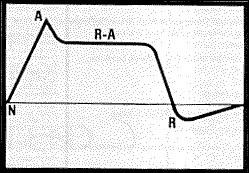Stress should not be confused with some of the normal stimuli of life. Getting up in the morning is stressful, taking a shower is stressful, but these stresses are the stimulation to perform or work adequately to utilize our potential facilities. There is a vast difference in the way stimulation from the responsibilities of a family and a financial goal affect one compared with the overwhelming stress that imminent bankruptcy or divorce would have. Our discussion here will concentrate on the latter form, the overwhelming stress which debilitates the body and which can produce disease -- both physical and emotional.
We must understand how external stress changes body chemistry in order to be able to understand the far reaching effect it has on the body. We must realize that stress must be of prolonged duration to create what we term disease. The short term or immediate changes that occur in the body under stress indicate to us the organs and glands involved in this reaction.
Let's visualize a man walking down a darkened street late at night, all alone. Suddenly footsteps are heard from behind; they get louder and louder, closer and closer. Visual images flash through his mind: robbery, assault, injury, hospital or whatever he may associate with because of his reading newspapers or watching television. If we were to examine them at this time we would find the following:
- Increased respiration
- Increased blood pressure
- Increased heart rate
- A cold sweat may have appeared
- The face will be pale
- Skeletal muscles will be tense
Dr. Hans Selye, who is probably the foremost researcher in the area of stress, would classify these signs as the first state of stress -- namely the alarm phase. Now that the alarm has been sounded there are two choices:
A. React to the stress, in this case begin running to get away or turn around and do battle (the "fight or flight" mechanism).
B. From an observation or reasoning point of view, relax and say to oneself, "There is no danger, so forget the signal."
This is the second stage of stress -- the reaction phase. I would like to emphasize that at times it is better to choose the action (A) response than the (B) "forget it" response to this type of stimulation. The hormones and other chemicals that produce the signs of stress are very potent (as they must be to cause such drastic physical changes) and should be expended by physical activity. As an example, the old adage that tells one to walk around the block if you get angry effectively dissipates these factors and they do not remain to interfere with normal metabolism. I guess grandma had some insight after all.
Now the third state of stress occurs -- the rest or recovery phase. The stimulus is gone, the reaction has occured; now the responsible glands have a chance to regroup, restore, and regenerate so they are ready to handle the next stress that comes along. We can graph the stress syndrome something like this:

This response is very normal in our lives and does no harm to the body. But if the R-A (reaction) line is lengthened and the R (recovery) line is shortened, with the next alarm phase coming quickly, we can have serious internal changes beginning to take place. The individual becomes exhausted and unable to combat the ever-present bacteria, viruses and other potential dangers to a healthy body. From this knowledge came a hypothesis that stress caused disease, and we can, with some accuracy, say that stress is very often, if not always, the forerunner of disease. But I draw the line there, because reasoning that stress causes disease could lead one to believe that disease has a mental origin since stress often manifests itself in mental or neurological signs.
I must firmly state that the mental manifestations of stress are a result of the body's inabilty to accommodate the stress response -- and that inability is usually due to malnutrition, which I will attempt to demonstrate next month when we look at the organs involved and the effect certain nutrients have on their function. We will also offer a simple stress test that can be used by any practitioner and is the best indicator of inability to accommodate stress available.
Kurt W. Donsbach, D.C.
San Ysidro, California




